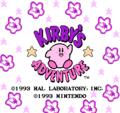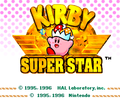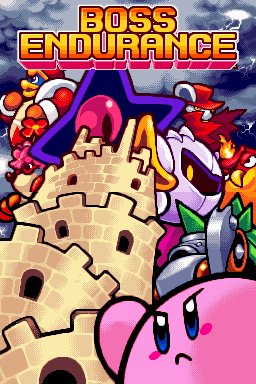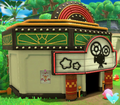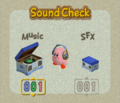User:Waddlez3121/Kirby Structure: Difference between revisions
Waddlez3121 (talk | contribs) (But wait, there's more!) |
Waddlez3121 (talk | contribs) m (→top) |
||
| (11 intermediate revisions by 3 users not shown) | |||
| Line 1: | Line 1: | ||
{{User:Waddlez3121/KSN}} | |||
This page is full of me rambling about how the Kirby games use their structure to apply challenge and function in unique ways. Essentially, I'm acting like I'm analyzing the games with direct game knowledge when I actually have no substantial knowledge whatever about game design. Maybe this page is an interesting, semi-accurate analysis; maybe it's a useful guideline to creating one's own fan game; or maybe I'm just spitting Halcandran language at you. Enjoy the show. | This page is full of me rambling about how the Kirby games use their structure to apply challenge and function in unique ways. Essentially, I'm acting like I'm analyzing the games with direct game knowledge when I actually have no substantial knowledge whatever about game design. Maybe this page is an interesting, semi-accurate analysis; maybe it's a useful guideline to creating one's own fan game; or maybe I'm just spitting Halcandran language at you. Enjoy the show. | ||
For the sake of simplicity, this page will generally cover mainline platforming titles. Spin-offs are not the focus of this page due to their lack of consistent formulas (compare ''[[Kirby's Block Ball]]'' and ''[[Team Kirby Clash Deluxe]]''). | |||
{{Notice | {{Notice | ||
| Line 10: | Line 14: | ||
Credit to [[User:ShadowKirby]]/ShadowMagolor for the template. To be more specific, feel free to correct any outright errors, but please ask me if you want to add any major analysis because we might be able to collaborate and combine. | Credit to [[User:ShadowKirby]]/ShadowMagolor for the template. To be more specific, feel free to correct any outright errors, but please ask me if you want to add any major analysis because we might be able to collaborate and combine. | ||
== | ==Overview== | ||
[[File:KSA Main menu.jpg|thumb|400px|right|All of Kirby's options here.]] | |||
''Kirby'' games have a lot of content to offer - some of it is recycled, but obviously there has to be some amount of original content. Below is a list of every common component in a game's library: | |||
*[[Story Mode]]: | *[[Story Mode]]: the main adventure for most players. Typically, this makes up most or all of the content in a game's completion tracker. | ||
*[[Sub-Game]]s: at least two per title starting in ''[[Kirby's Adventure]]'', these are here for five-minute fun and usually don't go very far | *[[Sub-Game]]s: at least two per title starting in ''[[Kirby's Adventure]]'', these are here for five-minute fun and usually don't go very far. | ||
**[[Theater]]: | **[[Theater]]: A small menu containing a most of a game's cinematics. | ||
**[[Sound Test]] / [[Jukebox]]: | **[[Sound Test]] / [[Jukebox]]: A repository of most or all of the game's music, and formerly the sound effects as well. | ||
*[[The Arena]] / [[Boss Endurance]]: | *[[The Arena]] / [[Boss Endurance]]: A gauntlet of boss battles, with varying leniencies to make the mode more or less fair. | ||
*[[Extra Mode]]: The extra mode | *[[Extra Mode]]: The extra mode varies in exact composition from game to game, but it is essentially a way to extend playtime without having to make a whole new campaign from scratch. | ||
== | <gallery> | ||
Unsurprisingly, there are a specific few games that are undeniably important to the ''[[Kirby (series)]]'' series as it stands in the modern day. Without further ado, here goes the list: | |||
*''[[Kirby's Dream Land]]'': | </gallery> | ||
**Introduced around two thirds of Kirby's basic moveset | ==History / Evolution of Important Mechanics== | ||
**Introduced a normal and hard mode, creatively reusing and swapping out assets | {{main|User:Waddlez3121/Kirby_Structure/Mechanical_Evolution}} | ||
** | Unsurprisingly, there are a specific few games that are undeniably important to the ''[[Kirby (series)|Kirby]]'' series as it stands in the modern day. Without further ado, here goes the list: | ||
*''[[Kirby's Dream Land]]'': | |||
**Introduced around two thirds of Kirby's basic moveset | |||
**Introduced a normal and rudimentary hard mode, creatively reusing and swapping out assets | |||
**[[Mt. Dedede]] is an early precursor to boss rushes | |||
**Introduced the [[Sound Test]], later to become the [[Jukebox]]. | **Introduced the [[Sound Test]], later to become the [[Jukebox]]. | ||
*''[[Kirby's Adventure]]'': | *''[[Kirby's Adventure]]'': | ||
**Greatly expanded on | **Greatly expanded on game length | ||
**Introduced sub-games | **Introduced sub-games | ||
**Introduced unlockable supplements to normal gameplay off of the beaten path with [[Big Switch]]es | **Introduced unlockable supplements to normal gameplay off of the beaten path with [[Big Switch]]es | ||
** | **Maps and the ability to revisit most content | ||
*''[[Kirby's Dream Land 2]]'': | |||
*''[[Kirby's Dream Land 2]]'': | **Introduced the per-game gimmick | ||
**Introduced the per-game gimmick | **First game to feature two endings | ||
**First game | *''[[Kirby Super Star]] ([[KSSU|Ultra]])'': | ||
**''Super Star'' started a menu system still in use today | |||
**Move lists and [[Special Page]]s | |||
*''[[Kirby Super Star]] ([[KSSU|Ultra]])'': | **''Ultra'' introduced the True Arena | ||
** | *''[[Kirby's Return to Dream Land]] (not [[KRtDLD|Deluxe]])''<ref>It's difficult to ascertain what impact RtDLD is going to have when the next game hasn't even been announced yet.</ref>: | ||
**Much of this game's impact comes from standardizing what other games did before | |||
**Move lists and | **Game engine suddenly became the new norm for everything up to ''[[Kirby Fighters 2]]'' | ||
**Optional stage content in the form of the [[dimensional rift]] to [[Another Dimension]] | |||
<gallery> | |||
File:KDL Title screen.png|The Kirbys go marching across the Game Boy. | |||
File:KA Title Screen.png|Kirby waves hello, surrounded by title text. | |||
File:KDL2 Title Screen SGB (without frame).png|The very colorful Super Game Boy title screen for ''Kirby's Dream Land 2'', sans frame. | |||
File:KSS title screen.png|[[Beam]] Kirby waves hello, surrounded by title text again. | |||
</gallery> | |||
*''[[Kirby's Return to Dream Land]] (not [[KRtDLD|Deluxe]])''<ref>It's difficult to ascertain what impact RtDLD is going to have when the next game hasn't even been announced yet.</ref>: | |||
** | |||
** | |||
** | |||
==Formula== | ==Formula== | ||
| Line 64: | Line 66: | ||
===Story Mode=== | ===Story Mode=== | ||
[[File:KSA Main menu.jpg|thumb|400px|right|Story Mode highlighted on the mode select for ''[[Kirby Star Allies]]''. Looks enticing.]] | |||
Story Mode is where most of the drama and the fun happens. You get a title screen, an opening cutscene, a random blurb in the manual, and... go! The point of story mode is that it's a really entertaining stepping stone. The story is separated into levels (often chapters in ''Super Star'') which are sub-divided into stages. Each stage has rooms; each room has an entry, an obstacle, and an exit; you get the idea. There are several recurring stage design elements, some of which can be found on [[User:ShadowKirby/Sandbox#Recurring level design elements|ShadowKirby/ShadowMagolor's user sandbox]]. | |||
A stage might contain a [[Mid-Boss]], or even several. One common type of stage in particular is the [[Tower of Mid-Bosses]], which is essentially the Arena before the Arena. A level will end in a boss, no matter what type of game it is. However, ever since ''Kirby's Adventure'', there has almost always been a distinction between the last level's [[boss]] and the overall story's final boss. Often, the final boss is fought with a [[Last Battle Ability]] and given its own level. Modern titles tend to give the option of fighting the level boss before the final boss, or skipping to the final boss, after having beaten both at least once beforehand. | A stage might contain a [[Mid-Boss]], or even several. One common type of stage in particular is the [[Tower of Mid-Bosses]], which is essentially the Arena before the Arena. A level will end in a boss, no matter what type of game it is. However, ever since ''Kirby's Adventure'', there has almost always been a distinction between the last level's [[boss]] and the overall story's final boss. Often, the final boss is fought with a [[Last Battle Ability]] and given its own level. Modern titles tend to give the option of fighting the level boss before the final boss, or skipping to the final boss, after having beaten both at least once beforehand. | ||
| Line 73: | Line 77: | ||
! Name !! Type !! Game !! Name !! Type !! Game | ! Name !! Type !! Game !! Name !! Type !! Game | ||
|- | |- | ||
| [[Poppy Bros. Sr.]] || Mid-Boss || ''[[Kirby's Adventure]]'' || [[ | | [[Poppy Bros. Sr.]] || Mid-Boss || ''[[Kirby's Adventure]]'' || [[Blocky]] || Mid-Boss || ''[[Kirby: Planet Robobot]]'' | ||
|- | |- | ||
| [[Rolling Turtle]] || Mid-Boss || ''[[Kirby's Adventure]]'' || [[Miasmoros]] || Mid-Boss || ''[[Kirby: Planet Robobot]]'' | | [[Rolling Turtle]] || Mid-Boss || ''[[Kirby's Adventure]]'' || [[Miasmoros]] || Mid-Boss || ''[[Kirby: Planet Robobot]]'' | ||
| Line 89: | Line 93: | ||
===Extra Mode=== | ===Extra Mode=== | ||
Extra modes feature all or most of the story mode's content again, but | [[filename|thumb|400px|right|[[Dededetour!]], an Extra Mode featuring King Dedede's [[Canon|non-canon]] journey to [[Floralia]].]] | ||
Extra modes feature all or most of the story mode's content again, but with certain restrictions in place. For example, in ''[[Kirby's Adventure]]'' and ''[[Kirby's Return to Dream Land]]'', Kirby's health is cut significantly, reducing the amount of damage he can sustain without losing a life. Alternatively, the player may be forced to choose a different character to control, such as in ''[[Kirby: Triple Deluxe]]'', ''[[Kirby: Planet Robobot]]'' and ''[[Kirby Star Allies]]''. In this case, truncations are more frequent as the game must tailor to the character's abilities - for example, [[Meta Knight]] has no issue cutting ropes, but he will be unable to complete puzzles based on moving objects with the [[Robobot Armor]] to destroy gold blocks. Notably, the original version of [[Meta Knightmare]] combined a lack of health with a new character choice. | |||
Extra modes almost always feature bosses that are made considerably more difficult, often sharing a designation relative to their counterparts. First introduced in [[Revenge of the King]], the "revenge" boss has been dubbed a number of things. | Extra modes almost always feature bosses that are made considerably more difficult, often sharing a designation relative to their counterparts. First introduced in [[Revenge of the King]], the "revenge" boss has been dubbed a number of things. | ||
| Line 114: | Line 120: | ||
===Boss Endurances (The Arena / The True Arena)=== | ===Boss Endurances (The Arena / The True Arena)=== | ||
[[File:KSqS Boss Endurance Screen.png|thumb|400px|right|This is no ordinary tower of bosses.]] | |||
Boss Endurances are a staple that, officially speaking, go as far back as ''Kirby's Adventure'' and, in reality, can be traced back to ''Kirby's Dream Land''. The purpose of the mode is simply to battle every boss from a certain point in the game, or matching certain criteria, until there are no more [[Boss Butch|bosses to butch]](er). | Boss Endurances are a staple that, officially speaking, go as far back as ''Kirby's Adventure'' and, in reality, can be traced back to ''Kirby's Dream Land''. The purpose of the mode is simply to battle every boss from a certain point in the game, or matching certain criteria, until there are no more [[Boss Butch|bosses to butch]](er). | ||
[[File:KDL Mt Dedede screenshot.png|thumb|left|Kirby stands in the foyer of [[King Dedede]]'s castle.]] | |||
[[Mt. Dedede]] is the first time a gauntlet of bosses was to be fought, replacing any actual stage content with a retread of one past room followed by a rematch with the corresponding boss. However, ''[[Kirby's Adventure]]'' and its mode select option of "V.S. BOSS!" was the first dedicated mode involving fighting bosses in sequence. | [[Mt. Dedede]] is the first time a gauntlet of bosses was to be fought, replacing any actual stage content with a retread of one past room followed by a rematch with the corresponding boss. However, ''[[Kirby's Adventure]]'' and its mode select option of "V.S. BOSS!" was the first dedicated mode involving fighting bosses in sequence. | ||
The differences between The Arena and general Boss Endurances are nominal, with most of them being simple standardization (or lack thereof.) Boss Endurances usually cause Kirby to fight exclusively level and final bosses in the order encountered in the story mode, and only two of these ([[The Ultimate Choice]] and the [[Colosseum]]) feature any kind of difficulty selection. The Arena consistently features a timer and choice of almost any [[Copy Ability]], mechanics with spotty representation in other Boss Endurances. Some Boss Endurances, like in ''Kirby 64'', may outright prevent Kirby from obtaining Copy Abilities at all. ''Kirby: Planet Robobot'' is the only game with an Arena to deviate from certain traditions of the mode, causing it to | The differences between The Arena and general Boss Endurances are nominal, with most of them being simple standardization (or lack thereof.) Boss Endurances usually cause Kirby to fight exclusively level and final bosses in the order encountered in the story mode, and only two of these ([[The Ultimate Choice]] and the [[Colosseum]]) feature any kind of difficulty selection. The Arena consistently features a timer and choice of almost any [[Copy Ability]], mechanics with spotty representation in other Boss Endurances. Some Boss Endurances, like in ''Kirby 64'', may outright prevent Kirby from obtaining Copy Abilities at all. ''Kirby: Planet Robobot'' is the only game with an Arena to deviate from certain traditions of the mode, causing it to be named a Boss Endurance in the Japanese and Korean versions. | ||
{| class="wikitable" | {| class="wikitable" | ||
| Line 127: | Line 137: | ||
| Bosses fought in order || Most Bosses fought in a random order || ''Kirby: Planet Robobot'' acts like a Boss Endurance in this regard. | | Bosses fought in order || Most Bosses fought in a random order || ''Kirby: Planet Robobot'' acts like a Boss Endurance in this regard. | ||
|- | |- | ||
| Mid-Bosses ignored || Mid-Bosses included || | | Mid-Bosses ignored || Mid-Bosses included || | ||
|- | |- | ||
| Varies; healing items may not be provided at all || Set number of [[Maxim Tomato]]es given at the start, replaced by normal Tomatoes later || ''Kirby: Planet Robobot'' acts like a Boss Endurance in this regard. | | Varies; healing items may not be provided at all || Set number of [[Maxim Tomato]]es given at the start, replaced by normal Tomatoes later || ''Kirby: Planet Robobot'' acts like a Boss Endurance in this regard. | ||
| Line 135: | Line 145: | ||
| No exclusive bosses || The True Arena features at least one secret boss || [[The Ultimate Choice]] and the [[Colosseum]] both feature exclusive bosses: those in The Ultimate Choice vary by difficulty; [[Meta Knight#Kirby and the Forgotten Land|Meta Knight]] is exclusive to the Colosseum, as are [[Phantom Meta Knight]] and [[Chaos Elfilis]]. | | No exclusive bosses || The True Arena features at least one secret boss || [[The Ultimate Choice]] and the [[Colosseum]] both feature exclusive bosses: those in The Ultimate Choice vary by difficulty; [[Meta Knight#Kirby and the Forgotten Land|Meta Knight]] is exclusive to the Colosseum, as are [[Phantom Meta Knight]] and [[Chaos Elfilis]]. | ||
|} | |} | ||
<gallery> | |||
File:KTD True Arena Menu.png|The True Arena, one of many Boss Endurances that tend to be the final stepping stone on the player's journey. | |||
</gallery> | |||
===Other Sub-Games=== | ===Other Sub-Games=== | ||
| Line 144: | Line 158: | ||
By contrast, the the '''Jukebox''' is often unlocked after completing story mode, and some tracks may have other unlock requirements. | By contrast, the the '''Jukebox''' is often unlocked after completing story mode, and some tracks may have other unlock requirements. | ||
<gallery> | |||
File:KBBl Main Menu.png|Upper title screen for ''Kirby's Blowout Blast'', a sub-game expansion. | |||
File:KatFL Waddle Dee Cinema screenshot.png|Waddle Dee Cinema, a Theater that's located inside a theater. | |||
File:K64 Sound Check menu.png|Kirby grooves in the Sound Check. | |||
</gallery> | |||
===Unlocking Content=== | ===Unlocking Content=== | ||
[[File:KRtDLD Complete main menu screenshot.png|thumb|400px|right|The mode select for ''[[Kirby's Return to Dream Land Deluxe]]'', now at 100% completion.]] | |||
Certain content is available from the very beginning of the game, while other events must occur for most content to be unlocked. | Certain content is available from the very beginning of the game, while other events must occur for most content to be unlocked. | ||
| Line 152: | Line 174: | ||
*Defeating the final boss of Story Mode usually yields the Jukebox, the Boss Endurance, and the Extra Mode, if applicable. | *Defeating the final boss of Story Mode usually yields the Jukebox, the Boss Endurance, and the Extra Mode, if applicable. | ||
*The first Boss Endurance and Extra Mode must both be completed to unlock harder Boss Endurances such as The True Arena, if applicable. | *The first Boss Endurance and Extra Mode must both be completed to unlock harder Boss Endurances such as The True Arena, if applicable. | ||
*The True Arena or its equivalent is often the final step in the player's journey, barring any recorded collectibles and Sub-Game rankings. When [[100% completion]] is achieved, a special reward is granted to the player. One of these is often the [[Kirby Master]] video in the Theater, or they might gain access to [[UFO#Kirby: Planet Robobot|an exclusive Copy Ability]]. | *The True Arena or its equivalent is often the final step in the player's journey, barring any recorded collectibles and Sub-Game rankings. | ||
*When [[100% completion]] is achieved, a special reward is granted to the player. One of these is often the [[Kirby Master]] video in the Theater, or they might gain access to [[UFO#Kirby: Planet Robobot|an exclusive Copy Ability]]. | |||
==Trivia== | ==Trivia== | ||
Latest revision as of 03:56, 20 April 2024
Part of a (userspace) series on Kirby game design |
|---|
| Entries: |
| Main article |
| Mechanical evolution |
This page is full of me rambling about how the Kirby games use their structure to apply challenge and function in unique ways. Essentially, I'm acting like I'm analyzing the games with direct game knowledge when I actually have no substantial knowledge whatever about game design. Maybe this page is an interesting, semi-accurate analysis; maybe it's a useful guideline to creating one's own fan game; or maybe I'm just spitting Halcandran language at you. Enjoy the show.
For the sake of simplicity, this page will generally cover mainline platforming titles. Spin-offs are not the focus of this page due to their lack of consistent formulas (compare Kirby's Block Ball and Team Kirby Clash Deluxe).
Credit to User:ShadowKirby/ShadowMagolor for the template. To be more specific, feel free to correct any outright errors, but please ask me if you want to add any major analysis because we might be able to collaborate and combine.
Overview[edit]
Kirby games have a lot of content to offer - some of it is recycled, but obviously there has to be some amount of original content. Below is a list of every common component in a game's library:
- Story Mode: the main adventure for most players. Typically, this makes up most or all of the content in a game's completion tracker.
- Sub-Games: at least two per title starting in Kirby's Adventure, these are here for five-minute fun and usually don't go very far.
- Theater: A small menu containing a most of a game's cinematics.
- Sound Test / Jukebox: A repository of most or all of the game's music, and formerly the sound effects as well.
- The Arena / Boss Endurance: A gauntlet of boss battles, with varying leniencies to make the mode more or less fair.
- Extra Mode: The extra mode varies in exact composition from game to game, but it is essentially a way to extend playtime without having to make a whole new campaign from scratch.
History / Evolution of Important Mechanics[edit]
- Main article: User:Waddlez3121/Kirby_Structure/Mechanical_Evolution
Unsurprisingly, there are a specific few games that are undeniably important to the Kirby series as it stands in the modern day. Without further ado, here goes the list:
- Kirby's Dream Land:
- Introduced around two thirds of Kirby's basic moveset
- Introduced a normal and rudimentary hard mode, creatively reusing and swapping out assets
- Mt. Dedede is an early precursor to boss rushes
- Introduced the Sound Test, later to become the Jukebox.
- Kirby's Adventure:
- Greatly expanded on game length
- Introduced sub-games
- Introduced unlockable supplements to normal gameplay off of the beaten path with Big Switches
- Maps and the ability to revisit most content
- Kirby's Dream Land 2:
- Introduced the per-game gimmick
- First game to feature two endings
- Kirby Super Star (Ultra):
- Super Star started a menu system still in use today
- Move lists and Special Pages
- Ultra introduced the True Arena
- Kirby's Return to Dream Land (not Deluxe)[1]:
- Much of this game's impact comes from standardizing what other games did before
- Game engine suddenly became the new norm for everything up to Kirby Fighters 2
- Optional stage content in the form of the dimensional rift to Another Dimension
Beam Kirby waves hello, surrounded by title text again.
Formula[edit]
Here's the breakdown:
Story Mode[edit]
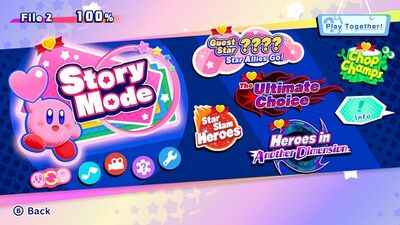
Story Mode is where most of the drama and the fun happens. You get a title screen, an opening cutscene, a random blurb in the manual, and... go! The point of story mode is that it's a really entertaining stepping stone. The story is separated into levels (often chapters in Super Star) which are sub-divided into stages. Each stage has rooms; each room has an entry, an obstacle, and an exit; you get the idea. There are several recurring stage design elements, some of which can be found on ShadowKirby/ShadowMagolor's user sandbox.
A stage might contain a Mid-Boss, or even several. One common type of stage in particular is the Tower of Mid-Bosses, which is essentially the Arena before the Arena. A level will end in a boss, no matter what type of game it is. However, ever since Kirby's Adventure, there has almost always been a distinction between the last level's boss and the overall story's final boss. Often, the final boss is fought with a Last Battle Ability and given its own level. Modern titles tend to give the option of fighting the level boss before the final boss, or skipping to the final boss, after having beaten both at least once beforehand.
| Name | Type | Game | Name | Type | Game |
|---|---|---|---|---|---|
| Poppy Bros. Sr. | Mid-Boss | Kirby's Adventure | Blocky | Mid-Boss | Kirby: Planet Robobot |
| Rolling Turtle | Mid-Boss | Kirby's Adventure | Miasmoros | Mid-Boss | Kirby: Planet Robobot |
| Whispy Woods | Level Boss | Kirby's Adventure | Clanky Woods | Level Boss | Kirby: Planet Robobot |
| King Dedede | Level Boss | Kirby's Adventure | Mecha Knight | Level Boss | Kirby: Planet Robobot |
| Nightmare | Final Boss | Kirby's Adventure | President Haltmann | Level Boss | Kirby: Planet Robobot |
| Dark Matter | Final Boss | Kirby's Dream Land 2 / 3 | Star Dream | Final Boss | Kirby: Planet Robobot |
The distinction between level bosses and final bosses, particularly during the finale of the game's story mode, can be hard to distinguish. The last-resort method I use to distinguish the two in games after Super Star is whether the extra mode revamps or replaces the boss, but the methods in the previous paragraph also work. Some weird cases deviate from this formula: Another Dimension (level) involves the Last Battle Ability throughout a shooter section, then featuring its own level boss before abandoning Landia to fight the game's final boss on foot.
Extra Mode[edit]
[[filename|thumb|400px|right|Dededetour!, an Extra Mode featuring King Dedede's non-canon journey to Floralia.]]
Extra modes feature all or most of the story mode's content again, but with certain restrictions in place. For example, in Kirby's Adventure and Kirby's Return to Dream Land, Kirby's health is cut significantly, reducing the amount of damage he can sustain without losing a life. Alternatively, the player may be forced to choose a different character to control, such as in Kirby: Triple Deluxe, Kirby: Planet Robobot and Kirby Star Allies. In this case, truncations are more frequent as the game must tailor to the character's abilities - for example, Meta Knight has no issue cutting ropes, but he will be unable to complete puzzles based on moving objects with the Robobot Armor to destroy gold blocks. Notably, the original version of Meta Knightmare combined a lack of health with a new character choice.
Extra modes almost always feature bosses that are made considerably more difficult, often sharing a designation relative to their counterparts. First introduced in Revenge of the King, the "revenge" boss has been dubbed a number of things.
| Game | Designation | Notes |
|---|---|---|
| Kirby Super Star Ultra | 's Revenge | The name of Masked Dedede's Revenge in Kirby: Triple Deluxe is a reference to this, since Masked Dedede was the only boss in Revenge of the King not given this title. |
| Kirby's Return to Dream Land / Deluxe | EX | The special page for Whispy Woods EX implies "EX" means "Extra", as does the classification of Soul Melter EX as "Extra". This is fitting, as these bosses are exclusive to Extra Mode. |
| Kirby: Triple Deluxe | DX | Though also implied by Flowery Woods DX's special page, additional Japanese material such as the Kirby Character Encyclopedia confirms that DX is read as "Deluxe" through furigana, referencing the game's title and their more grandiose appearances. |
| Kirby: Planet Robobot | 2.0 | In the Japanese and Korean versions of the game, boss names are instead prefixed "Re:" in reference to email replies (though the Japanese and Korean special pages for Clanky Woods 2.0 imply it stands for "Renewal"). |
| Team Kirby Clash Deluxe / Kirby Star Allies / Super Kirby Clash | Parallel | Indicates a stronger, alternate boss from Another Dimension. In the Japanese, German, Italian, Chinese and Korean versions of these games, the prefix is literally "Another". Parallel Susie and Parallel Nightmare are not fought in their base forms in their respective games, however. |
| Kirby and the Forgotten Land | Phantom | Indicates a stronger boss from the isolated isles of Forgo Dreams. Phantom bosses are copies created by Fecto Forgo's thoughts. |
| (several) | Soul | A formula introduced in Kirby: Canvas Curse to denote strong final forms of bosses. These bosses are often exclusive to The True Arena. |
Boss Endurances (The Arena / The True Arena)[edit]
Boss Endurances are a staple that, officially speaking, go as far back as Kirby's Adventure and, in reality, can be traced back to Kirby's Dream Land. The purpose of the mode is simply to battle every boss from a certain point in the game, or matching certain criteria, until there are no more bosses to butch(er).

Mt. Dedede is the first time a gauntlet of bosses was to be fought, replacing any actual stage content with a retread of one past room followed by a rematch with the corresponding boss. However, Kirby's Adventure and its mode select option of "V.S. BOSS!" was the first dedicated mode involving fighting bosses in sequence.
The differences between The Arena and general Boss Endurances are nominal, with most of them being simple standardization (or lack thereof.) Boss Endurances usually cause Kirby to fight exclusively level and final bosses in the order encountered in the story mode, and only two of these (The Ultimate Choice and the Colosseum) feature any kind of difficulty selection. The Arena consistently features a timer and choice of almost any Copy Ability, mechanics with spotty representation in other Boss Endurances. Some Boss Endurances, like in Kirby 64, may outright prevent Kirby from obtaining Copy Abilities at all. Kirby: Planet Robobot is the only game with an Arena to deviate from certain traditions of the mode, causing it to be named a Boss Endurance in the Japanese and Korean versions.
| Boss Endurances | The (True) Arena | Notes |
|---|---|---|
| Bosses fought in order | Most Bosses fought in a random order | Kirby: Planet Robobot acts like a Boss Endurance in this regard. |
| Mid-Bosses ignored | Mid-Bosses included | |
| Varies; healing items may not be provided at all | Set number of Maxim Tomatoes given at the start, replaced by normal Tomatoes later | Kirby: Planet Robobot acts like a Boss Endurance in this regard. |
| Copy Abilities are often limited, if at all present | Choice is available from almost every Copy Ability in the game | Kirby and the Amazing Mirror and Kirby: Squeak Squad both start Kirby in their respective Copy Ability Rooms. |
| No exclusive bosses | The True Arena features at least one secret boss | The Ultimate Choice and the Colosseum both feature exclusive bosses: those in The Ultimate Choice vary by difficulty; Meta Knight is exclusive to the Colosseum, as are Phantom Meta Knight and Chaos Elfilis. |
Other Sub-Games[edit]
There isn't much to analyze here because a sub-game can be literally any thought that popped into a developer's head. For the sake of brevity in an article that's already so dense, sub-games will not be listed or analyzed. See Sub-Game for any and all information.
There is, however, a more manageable amount to say about the Theater and Jukebox. These two are very similar in that they allow Kirby to view almost every cinematic and music piece, respectively, in each game they appear in. While the specifics vary, the general idea is the same. Exceptions do occur in early games, such as Kirby's Dream Land revealing a cheat code to unlock the Config Menu (and the Sound Test within) after the completion of Extra Mode, or Kirby's Dream Land 3 reserving the Theater for a 100% completion reward.
The Theater is usually unlocked after seeing a single cutscene for the first time. Since most modern games feature a cutscene at the very start of the story mode, this mode is unlocked very quickly.
By contrast, the the Jukebox is often unlocked after completing story mode, and some tracks may have other unlock requirements.
Unlocking Content[edit]
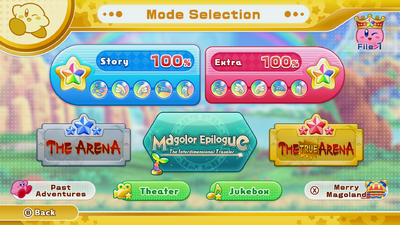
Certain content is available from the very beginning of the game, while other events must occur for most content to be unlocked.
- Story Mode is always available from the beginning, and Sub-Games usually are as well.
- The Theater is unlocked the moment the player is presented the first cutscene, although this isn't announced until the player next visits the mode select for that file.
- Defeating the final boss of Story Mode usually yields the Jukebox, the Boss Endurance, and the Extra Mode, if applicable.
- The first Boss Endurance and Extra Mode must both be completed to unlock harder Boss Endurances such as The True Arena, if applicable.
- The True Arena or its equivalent is often the final step in the player's journey, barring any recorded collectibles and Sub-Game rankings.
- When 100% completion is achieved, a special reward is granted to the player. One of these is often the Kirby Master video in the Theater, or they might gain access to an exclusive Copy Ability.
Trivia[edit]
- Kirby Super Star is the only game that includes The Arena without a True Arena counterpart, due to its remake being responsible for the addition of The True Arena to the series.
References
- ↑ It's difficult to ascertain what impact RtDLD is going to have when the next game hasn't even been announced yet.


